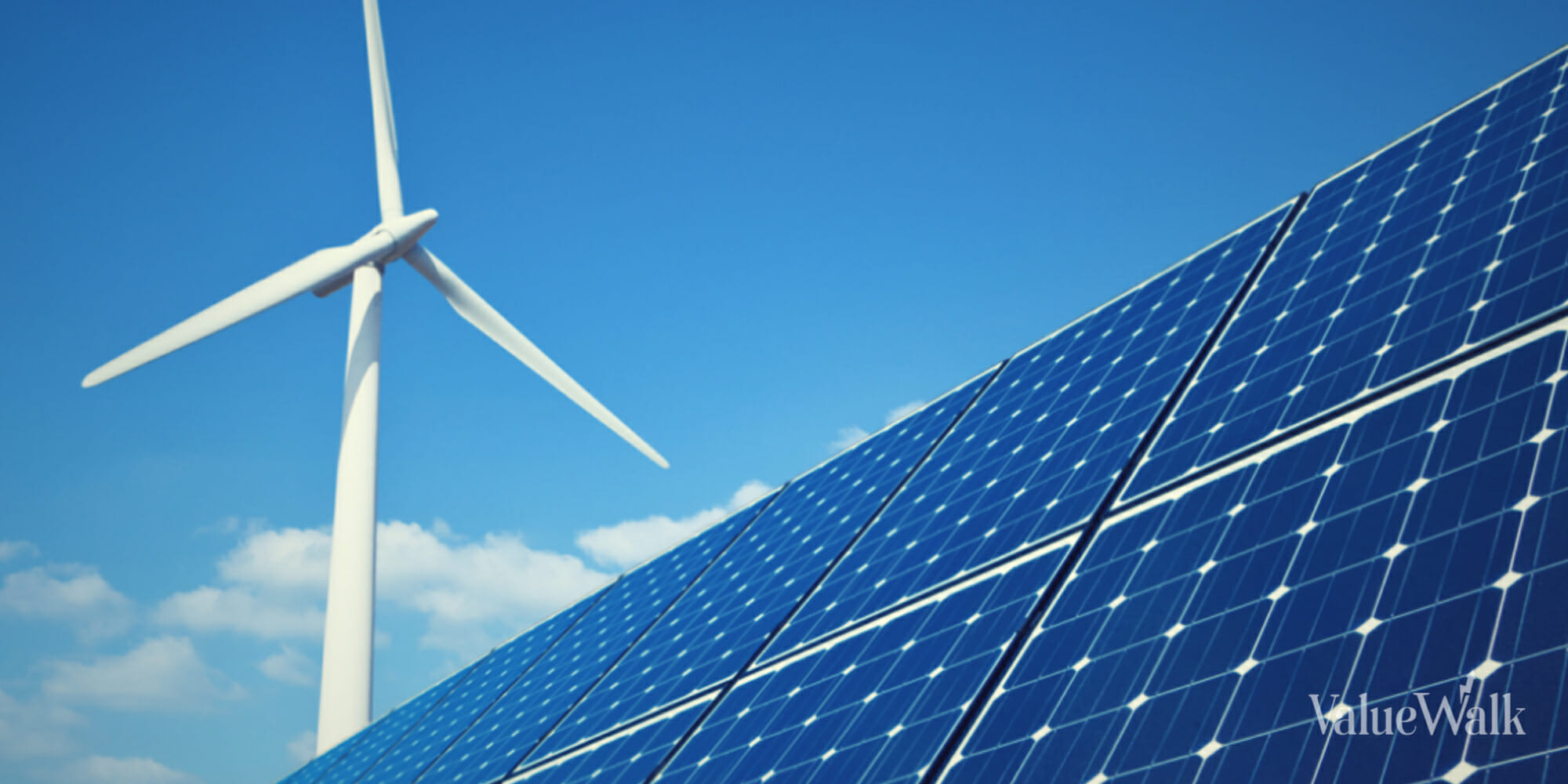Few industries have more long-term potential than clean energy technologies. The International Energy Agency’s goal of achieving net zero carbon dioxide emissions by 2050 is expected to drive the clean energy market. Net zero means that total emissions are equal to or less than the emissions removed from the environment.
A study by Straits Research puts the global renewable energy market at $1.085 trillion in 2023. Expanding at a compound annual growth rate of 9.47% through 2032, it will turn it into a $2.45 trillion market by that time, it estimates.
There are a lot of stocks that are connected to renewable energy, everything from companies that sponsor wind power, to solar panel makers, lithium-ion battery and hydrogen fuel-cell makers. Governments are also encouraging green energy through various subsidies and regulations.
However, renewable energy stocks’ recent performance has been mediocre. Over the past year, the S&P Global Clean Energy Index has fallen more than 21%. In many cases, the nascent industry has been the victim of rising costs due to inflation and increased interest rates. This short-term malaise, though, presents a solid opportunity for investors to buy promising clean energy stocks at reasonable prices because the industry’s long-term growth is considered all but guaranteed. We analysed renewable energy stocks in the UK, listed on the London Stock Exchange (LSE).
Here are five of the best UK renewable energy stocks that we’ve found:
How do these stocks stack up?
| Ticker | Company | Performance YTD |
| CWR | Ceres Power Holdings | +12.37% |
| ELIX | Elixrr International | -31.60% |
| 0RHE | Ørsted | +5.37% |
| GOOD | Good Energy Group | -35.79% |
| UKW | Greencoat UK Wind | -16.30% |
An in-depth look at the best renewable energy stocks UK
Our editors examined the top investments in renewable energy to buy now. View their selections to learn which five stock listings stand out.
1. Ceres Power Holdings: Average 10-year annualised return of 8.44%
The Horsham, England-based company develops solid oxide electrolyzer cell and solid oxide fuel cell technology for use in distributed power systems. Its products are helpful in decarbonising cities, factories, data centres and electric vehicle charging. Its fuel cell technology transforms hydrogen and oxygen into electricity. Ceres (LSE: CWR) also makes money from equipment sales and from licensing its technology to manufacturing partners such as Weichai, Bosch, Delta Electronics and Linde.

The firm isn’t profitable but it’s steadily growing revenue. In fiscal 2023, it had revenue of £22.3 million ($28.4 million), up 12.6%, while growing gross profit 27% to £13.6 million. The company also improved gross margin to 61% from 54%.
In January, the company signed a fuel cell and electrolysis licence contract with Delta that should give it extra revenue for years. It calls for staged revenues of £43 million through technology transfer and licensing, roughly half of which should register as 2024 revenue. Ceres also has fuel-cell partnerships with Bosch and South Korea’s Doosan and is calling for 2024 revenue to double over what it made in 2023, with revenue tripling by 2025 and profitability coming by 2027, according to estimates by Visible Alpha.
2. Elixrr International: Average four-year annualised return of 30.57%
The London-based global consultancy company offers its services to a multitude of industries, including the global energy, resources and utilities sector, where it’s helping clients make the transformation to carbon-neutral energy. Elixrr International (LSE: ELIX) benefits from the COP26 net zero commitment while avoiding the risks of linking its revenue solely to green energy, because its clients come from sectors ranging from insurance to healthcare and manufacturing, in some cases helping them significantly reduce their carbon emissions. It also works directly with prominent renewable energy clients such as Hitachi Energy.

The company has grown revenue by 250% since its initial public offering in 2020. In fiscal 2023, revenue rose 20% from fiscal 2022 to £85.9 million ($109.6 million), while profit before taxes rose 40% to £22.1 million. Next year, it’s estimating revenue to be between £104 million and £110 million, a rise of 24.5% at the midpoint.
The company has also grown its geographical diversification, with 44% of its business generated from the US, with 33% of its business in the UK and 23% from the rest of the world.
Elixrr has improved its dividend in sync with its growing revenue and cash flows. Last year, it paid out a dividend of 14.8 pence per share, up 37%. Its dividend yield is roughly 2.38%. It’s a small-cap stock, with a market cap of $276.55 million, so a lot of investors haven’t caught on to its growth, and it’s trading at roughly 17 times earnings. Excluding office leases, it also has no net debt.
3. Ørsted: Average eight-year annualised return of 6.26%
The Danish multinational energy company has its headquarters in Frederica, Denmark, where it’s the nation’s largest energy company. Ørsted (LSE: 0RHE) has been constructing and operating offshore wind farms in the UK for the past 20 years and has built more wind projects than any other company. Its 12 UK offshore wind farms power 4.5 million homes, and the company has another four UK wind farms in production, including what will be the world’s largest wind farm at Hornsea 3, with enough energy to power 3 million homes.

The firm saw its shares take a hit last year when it paid New Jersey $225 million to pull out of two offshore wind projects.citing inflation and higher interest rates, and the company booked a $4 billion impairment charge related to the US wind power portfolio. Earlier in the year, it halted its dividend and began cost-saving initiatives.
Despite those negatives, its finances are relatively solid. In the first quarter, it reported EBITDA of DKK 7.5 billion ($1.08 billion), up 8% from the same period a year ago, thanks to increased earnings from offshore wind sites. Revenue fell 25.4% year over year to DKK 19.7 billion. Net income also fell. It was down 19% from a year earlier to DKK 2.6 billion, a drop of 19%, due to higher interest expenses and a deferred tax liability. The company reiterated its full-year EBITDA guidance of between DKK 23 billion and DKK 26 billion, compared to DKK 21.62 in 2023.
Wind power, despite some setbacks, continues to be a focus point across the world to help achieve net-zero-emission goals. The company was picked for the Sunrise Wind project in New York and won two licences for offshore wind projects in Victoria, Australia.
4. Good Energy Group: Average 10-year annualised return of 0.55%
Based in Chippenham, England, it buys and sells electricity from renewable sources, and also sells gas and services connected to micro-renewable generation, solar and heat pump installation services. It also sells electric vehicle (EV) market data services. Good Energy (LSE: GOOD) operates in five segments: Electricity Supply, FiT Administration, Gas Supply, Energy as a Service (including Zap-map and nextgreencar.com) and Holding companies.

Good Energy has steadily grown its business through acquisitions.
It’s in the midst of a deal that would buy Kent-based JPS Renewable Energy and its wholly owned subsidiary, Trust Solar, for £13.75 million ($17.5 million). The deal bolsters the company’s solar expertise and fits with its strategy of chasing higher margin markets with less capital needs. It is trying to balance its energy services and energy supply earnings by next year.
In fiscal 2023, the company reported sales of £254.7 million, up 2.4%, while profit before tax rose from £1.4 million in 2022 (discounting a one-off revaluation benefit of £7.8m associated with Zapmap), to £5.7 million. Gross margin improved from 12% in 2022 to 17.4% in 2023. Going forward, the company sees business in the UK likely to grow, especially from increased heat pump, solar panel and EV charger installations.
Good Enegy also increased its dividend from 2.75 pence in 2022 to 3.25 pence in 2023, equaling a yield of around 1.29%.
5. Greencoat UK Wind: Average 10-year annualised return of 2.32%
The London-based company is the first renewable infrastructure fund to list on the London Stock Exchange main market and is the only infrastructure fund or renewable infrastructure fund located in the UK. Greencoat UK Wind (LSE: UKW) invests in operating UK wind farms, and has a share or owns wholly 49 wind farms from Stroupster in Scotland to Little Cheyne Court in Kent.

In 2023, the firm’s investments generated 4,743 gigawatt hours (GWh) of sustainable electricity, or approximately 1.5% of the UK’s electricity demand, enough to power 2.3 million homes. The company’s net asset value (NAV) dropped 2.5% last year to £3.8 billion as lower wind speeds and lower power prices cut into its margins. Despite that, it said it continues to look for more wind farm investments.
Greencoat has consistently increased its dividend at or above the retail price index (RPI), an inflation measure, and effective this year, boosted it 14.2% to 10 pence, delivering a current yield of around 7.65%. Despite the high dividend, the company has been able to maintain dividend coverage of 2.0x, it said. It also approved a share repurchase program of up to £100 million.
What are renewable energy stocks?
Renewable energy stocks are stocks of companies that are involved in the research, development, production, or installation of renewable energy technologies. These technologies include solar, wind, geothermal, biomass, and hydropower.
Companies that make renewable energy can be broadly classified into two categories: those that manufacture the technology used to generate renewable energy, and those that develop and operate renewable energy projects.
Here are some of the leading companies in each category:
- Manufacturers of Renewable Energy Technology
- Solar panel manufacturers: These companies produce solar panels, which convert sunlight into electricity. Some of the biggest names in solar panel manufacturing include JinkoSolar, Canadian Solar, and Longi Solar.
- Wind turbine manufacturers: These companies design and build wind turbines, which use wind to generate electricity. Leading wind turbine manufacturers include Siemens Gamesa, Vestas Wind Systems, and GE Renewable Energy.
- Hydropower equipment manufacturers: These companies produce turbines, generators, and other equipment used in hydroelectric power plants, which generate electricity from moving water. Major hydropower equipment manufacturers include Andritz, GE Renewable Energy, and Voith Group.
- Developers and Operators of Renewable Energy Projects
- Independent power producers (IPPs): These companies develop, finance, own, and operate renewable energy projects, such as solar farms and wind farms. Some of the largest IPPs in the world include NextEra Energy, Enel Green Power, and Iberdrola.
- Utilities: Many traditional electric utilities are increasingly investing in renewable energy projects, either by building their own projects or by purchasing renewable energy from IPPs. Examples of utilities with a strong focus on renewables include NextEra Energy, Duke Energy, and Ørsted.
Renewable energy is becoming an increasingly important part of the global energy mix as countries look to reduce their reliance on fossil fuels and combat climate change. As a result, renewable energy stocks are seen as a potential growth area for investors.
Pros and cons of investing in renewable energy stocks
Here are some of the benefits of investing in renewable energy stocks:
- Growth potential: The renewable energy sector is expected to grow significantly in the coming years, driven by government policies, technological advancements, and increasing demand for clean energy.
- Environmental benefits: By investing in renewable energy, you are helping to support the transition to a more sustainable energy future.
- Diversification: Renewable energy stocks can help diversify your investment portfolio and limit your exposure to the risks associated with traditional energy sources.
- Above-average dividends: While renewable energy stocks often pay dividends with lower yields than that is paid by typical utility companies, some renewable energy stocks, such as Elixrr International and Greencoat UK Wind, do pay above-average dividends.
Some of the risks involved with renewable energy stocks:
- Policy uncertainty: Government policies can have a significant impact on the renewable energy sector. If government support for renewables weakens, it could hurt the profitability of renewable energy companies.
- Competition: The renewable energy sector is becoming increasingly competitive, which could put downward pressure on prices.
- Technological risk: The renewable energy sector is still relatively young, and there is always the risk that new technologies could emerge that make existing technologies obsolete. Developing new technologies is more expensive than that of established technologies in many cases, increasing the risk for renewable energy companies.
Renewable energy stocks FAQs
How to invest in renewable stocks in the UK
First, check to see if your brokerage account will allow you to trade renewable stocks stocks that you want to buy. Make sure the stock is registered with the proper regulators to avoid unregistered scams.
As with any stock, you need to do your own research before investing, looking at a company’s earnings reports going back a few years. Make sure the company is on solid financial footing and appears to be headed in the right direction. Be especially cautious at first. Even as s stock’s valuation appears attractive, it makes sense to proceed slowly with smaller buys at first to test the viability of your investment.
Do I need to pay tax on renewable stocks in the UK?
Generally yes. Consult a tax professional regarding your specific situation, but there are two types of taxes affecting penny stocks in the UK, Capital Gainst Tax (CGT) and Stamp Duty Reserve Tax (SDRT).
The CGT applies to profits made when selling stocks outside of tax-efficient accounts like ISAs or SIPPs. The amount of tax owed depends on your income tax bracket.
The SDRT is a 0.5% tax paid when buying UK-listed stocks, which is not applicable for most overseas shares or exchange-traded funds (ETFs).
Tax-efficient accounts like ISAs and SIPPs shelter your investments from taxes like CGT. However, SDRT might still apply to non-UK holdings within these accounts.
Transferring stocks in the UK
Transferring stocks in the UK generally means moving them between your own accounts with different providers or giving them to someone else. Transfers are best done electronically, but can still take several days.
If you transfer stocks between your accounts, you can avoid selling and repurchasing shares, saving on fees and capital gains tax. Generally, you need to initiate the transfer with your brokerage, remembering that there may be exit fees.
If you transfer your stock to someone else, you’ll need to fill out a stock transfer form and if you have physical certificates, they need to be included in the transfer. Depending on the value of your shares, a stamp duty might apply and there are other tax consequences best left up to a tax professional.
Methodology: How we made our selections
To find the best UK renewable energy stocks, we focused first on renewable energy companies that traded on the London Stock Exchange and were located in the UK with their primary business being in the UK. We also included Ørsted, a Danish company listed on the London Stock Exchange, because much of its business is connected with UK wind farms.
Then, we looked for companies that grew revenue or EBITDA last year. The only exception was Greencoat UK Wind, which was able to grow its cash reserves enough to continue to raise its dividend.
Even though they may have struggled at times, all of the companies have solid long-term growth potential and are trading at reasonable price-to-earning ratios.
References
Straits Research renewable energy market report
Ceres Power Holdings 2023 report
Elixrr 2023 investor presentation
Good Energy 2023 annual report










